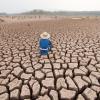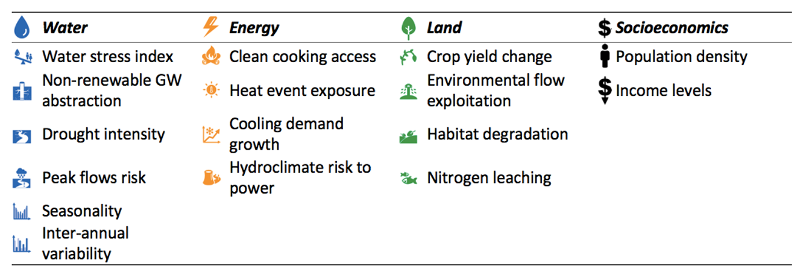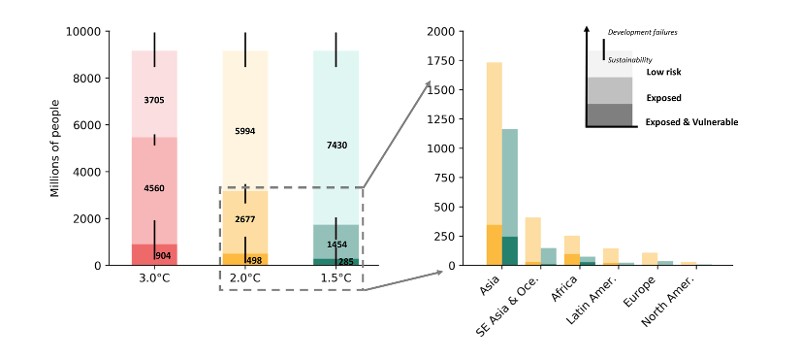
Policy Brief #21, December 2018. IIASA research shows substantial benefits of climate mitigation and achieving the 1.5°C target, as well as where action is most urgently required to reduce the vulnerability of the world’s poorest to unavoidable climate impacts.
- With the world already around 1°C warmer than pre-industrial averages, achieving the 1.5°C target of the Paris Agreement could almost halve the number of people exposed to hotspots of climate risk compared to a warming to 2°C.
- At 1.5°C of warming, 16% of the global population–1.5 billion people–are expected to live in climate change hotspots. At 2°C, this almost doubles to 29% of the global population–2.7 billion people. At 3°C of warming, that figure almost doubles again, to 50% of the population, or 4.6 billion people.
- Asian regions, Africa, and Latin America face high proportions of exposed population compared to their total population.
- Exposure in Asian regions is the most severe, even at 1.5°C, in proportional and absolute terms, due to the high concentrations of population and the high multisector risks of those regions.
- Africa fares worse than most regions, especially in high inequality socioeconomic scenarios and high warming climate scenarios. At 1.5°C, the vast majority of exposed and vulnerable population is in Asia, while at 3°C, 27-51% are in African regions.
- Targeting socioeconomic development in hotspot areas is particularly important for reducing vulnerability in places where impacts are expected to be most severe.
- Ambitious sustainable development in hotspot areas could reduce the number of people who are exposed and vulnerable by an order of magnitude, from 1.5 billion to 100 million at 1.5°C.
- Proactive adaptation through mechanisms such as the Sustainable Development Goals would greatly reduce vulnerability to shocks like climate hazards that frequently prevent people escaping poverty.
- Policies and investments aiming to keep global temperature limits below 2°C, will deliver the greatest benefits..
The problem
The Paris Agreement, which was signed by 195 nations in 2015, articulates a long-term goal of “keeping the increase in global average temperature to well below 2°C above pre-industrial levels and to pursue efforts to limit the increase to 1.5°C”. While there is much evidence on the risks of higher levels of global warming, the differences between 1.5°C and 2°C change are less well understood.
There is increasing evidence that the world’s poorest are disproportionately exposed to climate risks, including changes in temperature extremes and challenging hydro-climatic complexity. Those in poverty are much more vulnerable to climate change impacts, which also prevent them from escaping poverty. Knowing where and how many vulnerable people are at high risk is important for creating policies to mitigate the situation.
Is half a degree important?
IIASA research conducted as part of the Integrated Solutions for Water, Energy, and Land (ISWEL) project found substantial benefits for keeping global mean temperatures as low as 1.5°C.
According to the results which featured in the recent IPCC Report on Global Warming of 1.5°C, avoiding a 2°C increase could almost halve the number of people exposed to multisector impacts from 2.7 billion to 1.5 billion. In addition to reducing both the population exposed and severity of impacts in highly populated parts of Asia, exposure to multisector risks is avoided in large parts of Africa, particularly in East and West Africa. Subsequently, the number of low income (i.e., those with an income of less than US$10 per day), vulnerable people exposed is also greatly reduced from 0.5 billion to 0.29 billion.
Study framework
The objective of the study was to assess the exposure to and vulnerability of future populations to overlapping multisectoral hotspots. State-of-the art models were used to assess the future trends of 14 indicators of development and climate-induced challenges linked to three sectors–water, energy, and land. Three climate change scenarios were used representing global mean temperature rises of 1.5°C, 2°C, and 3°C compared to pre-industrial conditions. In addition, high-resolution projections of population, Gross Domestic Product (GDP), and income were developed for three socioeconomic scenarios ranging from sustainability successes to development failures.
 © IIASA
© IIASA
Indicators that were modelled to assess risk across the sectors.
Water risks
Water risks are projected to be higher in locations where future water availability is unlikely to meet demand and hydro-climate variability is growing. Surface and groundwater stress are in part demand driven and tend to be concentrated in population centers and intense water demand regions. More intense droughts and variability in water supply affect larger areas of land, including cropland. Areas of particular concern include Central and South Asia, the Mediterranean, the Middle East, southwest of North America, south of Latin America, and North Africa.
Energy risks
Higher energy risks are very much concentrated around the tropics and overlap with locations of higher air temperatures and population density. This is because of rising air temperature changes that drive cooling energy demand and heat event exposure, particularly in the tropics. Areas of particular concern include Indonesia and West Africa, where exposure is driven by low clean cooking fuel access, more heatwaves, and higher cooling demands. Large areas across the tropics present consistently low-medium levels of risk.
Land risks
Land sector impacts are widespread and cover large portions of all continents, particularly in agricultural areas. Nitrate leaching to watercourses from agricultural fertilizer use is a widespread risk with large areas exceeding sustainable levels. Crop yield reductions and habitat degradation are also expected in some places. Unsustainable irrigation water use
increases in areas already dependent on irrigated agriculture, including China, North America, and South Asia. Areas of particular concern include the Midwest United States, Southeast Brazil, Ethiopia and South Sudan, the Mediterranean, and most of South and Southeast Asia.
Multisector risk
Multisector risk occurs at locations where two or more of the above sectors include multiple indicators surpassing tolerable levels of risk, such as locations that are expected to face various land and water challenges. At higher levels of warming, growth in both the size and intensity of hotspots can be expected.
First, the area of land affected by multisector risks increases fivefold when moving from a 1.5°C to 3°C temperature increase (from 3% to 16%). Most of these hotspots overlap with the areas of high population density. At 1.5°C, hotspots emerge predominantly in South Asia. At 2°C, hotspot areas also include larger areas of South- and East Asia, East- and West Africa, and Central America.
Second, the risk scores intensify in some locations between the 1.5°C and 3°C scenarios. Areas with particularly high multisector risk scores include Central America, East Africa and West Asia, the Mediterranean, the Middle East, and parts of India and East China.
 © IIASA
© IIASA
Left: With 2°C impacts about 2.7 bi would be exposed of which 0.5 bi would be both exposed and vulnerable. Keeping global temperatures below 1.5°C would almost halve the number of people exposed. Right: Substantial reductions of the exposed and vulnerable
About this research and the ISWEL project
The International Institute for Applied Systems Analysis (IIASA) is leading the Integrated Solutions for Water, Energy, and Land (ISWEL) project in partnership with the Global Environment Facility (GEF) and the United Nations Industrial Development Organization (UNIDO). The main goal of the project is to explore cost-effective solutions to jointly meet water, land, and energy demands under different development and climate pathways.
The hotspots assessment involved more than 20 researchers from IIASA across the Energy, Water, and Ecosystem Services and Management programs. The work was led by Edward Byers ([email protected]) and this policy brief has been additionally supported by contributions from Ansa Heyl, Barbara Willaarts, Simon Langan, and Keywan Riahi.
IIASA Policy Briefs present the latest research for policymakers from IIASA - an international, interdisciplinary research institute with National Member Organizations (NMOs) in countries in Africa, the Americas, Asia, and Europe. The views expressed herein are those of the researchers and not necessarily those of IIASA or its NMOs.

